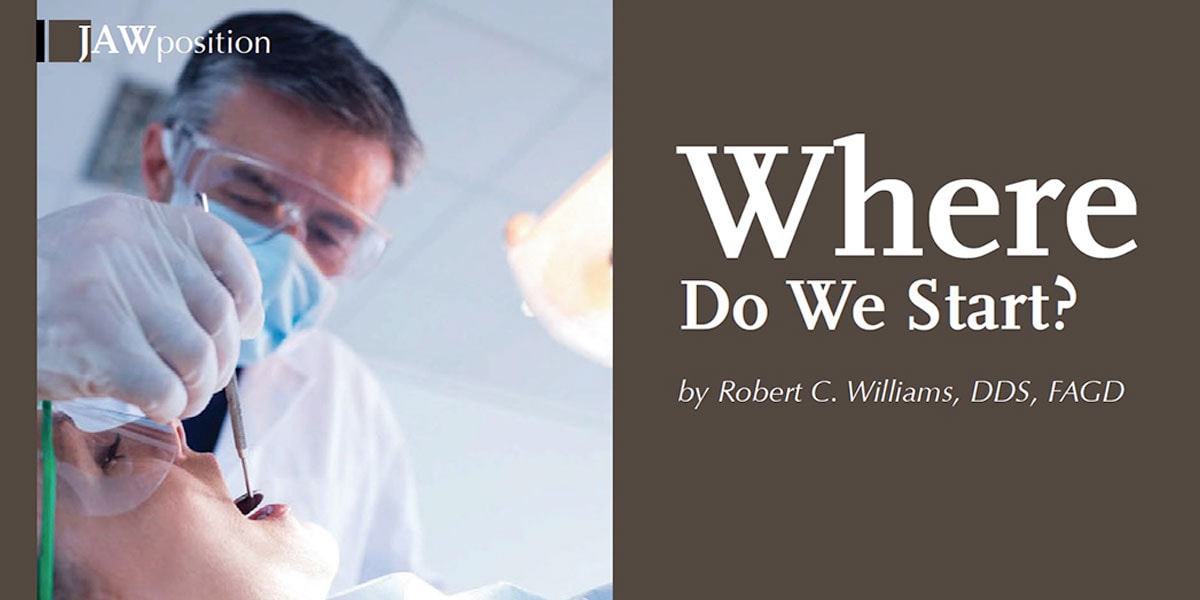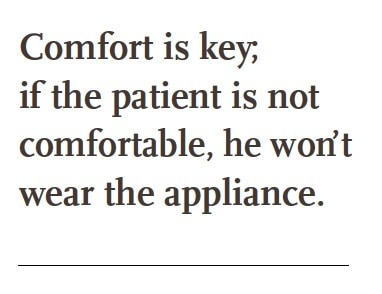
by Robert C. Williams, DDS, FAGD
You just took a course in “Treating Sleep Apnea in the Dental Practice” and you are ready to start. Your patient is ready to start. Start where?
You learned all kinds of terms and acronyms (AHI, RDI …). You were shown this new device called a George Gauge – which you supposedly set at 60-70% of maximum protrusion, send to the lab, and deliver the appliance to the patient and everyone is happy and breathing better at night. Plus they said you were going to make a boat load of money! Sounds great, right? Or are there more areas you need to keep in mind? I will attempt to take you through the Who, When, Why and How you take a bite registration for a MAD (Mandibular Advancement Device).
Who can do this? You – as the dentist. Every MAD works by protruding the mandible. To make a stable appliance, we must determine the best place forward that opens the airway and provides enough posterior clearance to fit the chosen device. We want to find the optimum spot somewhere along that continuum between the most retruded demonstrated position and where they protrude maximally. The Class 3 patient with a very flat protrusive angle may have limited posterior clearance, while a severe Class 2 with a deep overbite will have a very large posterior clearance on opening. Also, if you have a patient with a severely retruded jaw and forward head position, you could collapse the airway if you move the jaw too far forward. So there is more to evaluate in a patient then to simply check their protrusive and retrusive relationships and set at 60% or 70% and fit the appliance. You may get away with it most the time, but we, as specialists of the mouth and jaw, can do better.
The When is simple: after the dentist receives a prescription to “Make an Oral Device” from a physician to treat the patient’s OSA. Why? Because we are in a perfect position to evaluate the oral environment. We need to think of ourselves more as physicians of the mouth, not just filling holes in teeth or rebuilding occlusions. We need to include questions in our health history about sleep such as history of PAP use, and screening questions such as STOP BANG, AIRES, and ESS. Our exam should include tongue, palate and pharyngeal structures – is it difficult for you to see the back of their throat? Ask them – have they been told they snore and they say “oh yes, my wife sleeps in the other room”. Check their jaw relationship (Cl 1, 2, and 3), and for any evidence of occlusal wear from bruxism. We can also do a thorough TMJ evaluation including muscle palpation, joint noise and/or pain. Trust me – your patients may not have experienced such a thorough exam and will be impressed with your concern not just for their teeth, but their whole being. At this point you can evaluate whether they are a good candidate for a MAD.

Now let us get to the How of taking a bite registration for the MAD. I will discuss four options for determining the correct bite registration position. The first two are Airway Metrics and the Andra Gauge. Both depend on the patient’s subjective feedback of snoring sounds, which can help educate the patient about their problem while you are developing a starting point for setting your appliance. The Airway Metrics, (www.airwaymetrics.com) some say, is practical, simple, repeatable, and accurate in finding the airway target position. It comes with bite forks, handles, and 15 mandibular positioning simulators that give you a broad range of both A/P and vertical positions that can quickly provide a selected bite registration position which is the most comfortable for the patient. The Andra Gauge (http://www.andragauge.com) is a single compact device which adjusts A/P, vertical, and sagittal positions. This will allow you to precisely position the jaw in three dimensions; you use a step-back approach by decreasing the A/P and opening the vertical so you can find a more compatible position. Unfortunately, the entire device goes to the lab which increases the cost.
 The George Gauge, developed in the 1980’s by Dr. Peter George, an orthodontist practicing in Honolulu, Hawaii. (Side note: he’s a Gold and Silver Olympic medalist in weightlifting between1948 and 1956 while completing dental school.) After attending a course with a local oral surgeon on orthognathic surgery concepts in 1983, the surgeon told Dr. George the story of a patient with severe OSA. Dr. George offered to make an appliance for the patient and dropped the AHI (Apnea-Hypopnea Index) from 79 to 4 as a result. He developed his positioning device to make this process easier; through the years this has been the most used device for bite registration worldwide, distributed through Great Lakes Orthodontics.
The George Gauge, developed in the 1980’s by Dr. Peter George, an orthodontist practicing in Honolulu, Hawaii. (Side note: he’s a Gold and Silver Olympic medalist in weightlifting between1948 and 1956 while completing dental school.) After attending a course with a local oral surgeon on orthognathic surgery concepts in 1983, the surgeon told Dr. George the story of a patient with severe OSA. Dr. George offered to make an appliance for the patient and dropped the AHI (Apnea-Hypopnea Index) from 79 to 4 as a result. He developed his positioning device to make this process easier; through the years this has been the most used device for bite registration worldwide, distributed through Great Lakes Orthodontics.
The George Gauge and Pro Gauge from Airway Technologies vary slightly. The George Gauge has vertical openings of 2mm and 5mm, while the Pro Gauge has a 4, 6, 9, and 12mm vertical opening choices. The George Gauge adjusts over the lower incisors and is fitted by tightening the lower screw. Both gauges must fit over the incisal edges of the upper, so sometimes you must adjust the notches to fit if the teeth are severely worn. Then, both gauges work like this: Step 1: Center gauge on lower anterior teeth and make any appropriate adjustments to align the body of the gauge with the plane of occlusion. Step 2: With the patient holding the gauge between the incisors, instruct him/her to slide jaw forward as far as possible. Note the + reading on the millimeter scale. Then ask patient to move jaw back as far as he/she can. Note the – reading. Repeat 2-3 times to insure consistency. Also notice any deviation in the midline which could affect the outcome. The total distance between maximum + and – is the protrusive range. Step 4: multiply that sum by .7 (70%) and add this number to the minus number (retrusive position). This may or may not be your Therapeutic Position. You will find in some cases that as you increase the vertical you can decrease the protrusive position. Let’s say the patient is not comfortable in the 70% position, and the patient is still making a considerable snoring sound with the George Gauge 5 mm opening, so with the Pro Gauge you could try a 9 mm vertical opening and set the protrusive setting to 50% and patient is making a very slight snoring sound and feels more comfortable. Comfort is key; if the patient is not comfortable, guess what, he won’t wear the appliance. By adding the snoring-sound portion to your treatment routine you will increase your success and comfort for your patient, similar to the Andra and Airway Metric guides. Setting the initial jaw position is currently as much art as science. Since all the MAD are adjustable, so don’t let precise positioning of the starting position be a barrier to getting started.
 Pro Gauge vs George Gauge: With cold sterilization being more and more questionable, the ability to heat sterilize instruments becomes more desirable. The George Gauge can’t be heat sterilized while the Pro Gauge, which has more vertical options and an easier-to-read millimeter scale, can. These features make it a superior choice. The Pro Gauge is also distributed through Great Lakes Orthodontics.
Pro Gauge vs George Gauge: With cold sterilization being more and more questionable, the ability to heat sterilize instruments becomes more desirable. The George Gauge can’t be heat sterilized while the Pro Gauge, which has more vertical options and an easier-to-read millimeter scale, can. These features make it a superior choice. The Pro Gauge is also distributed through Great Lakes Orthodontics.
Bite records are the same basically for all devices; mark the center line and record full occlusal coverage to stabilize the cast mounting. Once the position is set, bite registration material is added to the top and bottom of the bite fork all the way back to the posteriors, then return the marked bite fork to the midline and guide patient into upper groove. It’s recommended that once a position is obtained that you ask the patient to hold in that position for 2-3 minutes and seek feedback. If they are not comfortable there, adjust that position less protrusive a bit and try again. Also patients with a history of TMD may need a less aggressive starting position, but that’s a subject for another essay.
It’s important for your patients to be involved in their therapy; starting where they are comfortable and where they feel their snoring will be quieter leads them to positive thoughts starting out. You and I know that only use of the device and objective testing will truly determine the therapeutic position; that’s why we make our devices adjustable. But we have to start somewhere!





